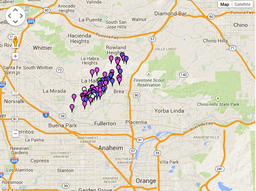Difference between revisions of "HighF v14.12"
From SCECpedia
Jump to navigationJump to search| Line 2: | Line 2: | ||
This page collects information about a proposed high frequency verification and validation exercise. Planning started in Dec 2014. | This page collects information about a proposed high frequency verification and validation exercise. Planning started in Dec 2014. | ||
| − | + | ||
| − | |||
| − | |||
| − | |||
| − | |||
| − | |||
| − | |||
| − | |||
| − | |||
| − | |||
| − | |||
| − | |||
| − | |||
| − | |||
== Station Lists == | == Station Lists == | ||
| Line 164: | Line 151: | ||
== References Used == | == References Used == | ||
* Taborda, R. and J. Bielak (2013). Ground-motion simulation and validation of the 2008 Chino Hills, California, earthquake, Bull. Seismol. Soc. Am. 103, no. 1, 131–156, doi 10.1785/0120110325. | * Taborda, R. and J. Bielak (2013). Ground-motion simulation and validation of the 2008 Chino Hills, California, earthquake, Bull. Seismol. Soc. Am. 103, no. 1, 131–156, doi 10.1785/0120110325. | ||
| + | |||
| + | == Agreements Needed == | ||
| + | * Simulation Volumes | ||
| + | * Rotation Angle | ||
| + | * Projections used | ||
| + | * Points per wavelength used | ||
| + | * Number and location of sites used for ground motion comparison | ||
| + | * Proposed Station List to save results | ||
| + | * La Habra Point Source parameters | ||
| + | * Currently available code capabilities in GPU codes | ||
| + | ** small scale heterogeneities | ||
| + | ** FDQ | ||
| + | ** Plasticity | ||
| + | ** dynamic rupture source | ||
| + | * V and V exercise stages - need to be reviiewed and approved | ||
Revision as of 16:28, 24 March 2015
Contents
- 1 High-F 14.12 Verification and Validation Exercise
- 2 Station Lists
- 3 Source Description
- 4 Volume
- 5 1D Velocity Model Definition
- 6 Simulation Box / Velocity Model
- 7 Solver Parameters
- 8 High-F VandV Exercise Planning Documents (2015)
- 9 High-F Project Plan (2012)
- 10 References Used
- 11 Agreements Needed
- 12 Related Entries
High-F 14.12 Verification and Validation Exercise
This page collects information about a proposed high frequency verification and validation exercise. Planning started in Dec 2014.
Station Lists
- En-Jui Station List w/ Simulation Region (KML Format)
- En-Jui Station List (Text Format)
- Hercules La Habra Stations
Source Description
Trimmed, low-pass filtered (fc=5Hz, Butterworth, 2 forward passes, 4 poles), 4300 points, dt=0.001s (and plot of what is should look like).
- Time domain Plot of Select Source
- Data File For 5Hz Plot
- Source Frequency Domain Plot w/ and w/o Filtering
Volume
The four corners are:
- -119.288842 34.120549
- -118.354016 35.061096
- -116.846030 34.025873
- -117.780976 33.096503
Volume size:
- 180,000 m x 135,000 m x 61,875 m = 1.503e15 m3
1D Velocity Model Definition
Simulation Box / Velocity Model
| Parameter | Value | Notes |
|---|---|---|
| Dimensions (km) | 180 x 135 x 61.875 (31 km for 1d Model) | |
| Bounding Box (LL) | -119.288842 34.120549, -118.354016 35.061096, -116.846030 34.025873, -117.780976 33.096503 | |
| Rotation Angle | 39.9 | |
| UCVM Version | 14.3.0 | No heterogeneities |
| Velocity Model Versions | CVM-S4v26 | |
| Miniumum Vs | 500 m/s | |
| Samples per wavelength | 6 to 7 - AWP | 10 to 12 - Hercules |
Point Source Parameters
| Parameter | Value | Notes |
|---|---|---|
| Event Name | La Habra | |
| Mw | 5.1 | Ref: http://www.scsn.org/2014lahabra.html |
| Moment | 5.764 E+23 Dyne-cm | Source: En-Jui |
| Origin Time | 2014/03/29 04:09:42.97 | Source: En-Jui |
| Origin Location | -117.930; 33.922; 5.0km | Source: En-Jui |
| Strike/Dip/Rake | 239/70/38 | Source: En-Jui, based on review of aftershock sequence |
| Rise Time | 0.75 s |
Solver Parameters
| Parameter | Value | Notes |
|---|---|---|
| Frequency | 4.0 Hz | |
| Simulation Length (Duration) | 100 s | |
| Delta T | 0.005 | |
| Plane Output Resolution | 250m | |
| I/O Print Rate | every 10 steps | |
| Station List | TBD | |
| Software Version | TBD |
High-F VandV Exercise Planning Documents (2015)
High-F Project Plan (2012)
References Used
- Taborda, R. and J. Bielak (2013). Ground-motion simulation and validation of the 2008 Chino Hills, California, earthquake, Bull. Seismol. Soc. Am. 103, no. 1, 131–156, doi 10.1785/0120110325.
Agreements Needed
- Simulation Volumes
- Rotation Angle
- Projections used
- Points per wavelength used
- Number and location of sites used for ground motion comparison
- Proposed Station List to save results
- La Habra Point Source parameters
- Currently available code capabilities in GPU codes
- small scale heterogeneities
- FDQ
- Plasticity
- dynamic rupture source
- V and V exercise stages - need to be reviiewed and approved
